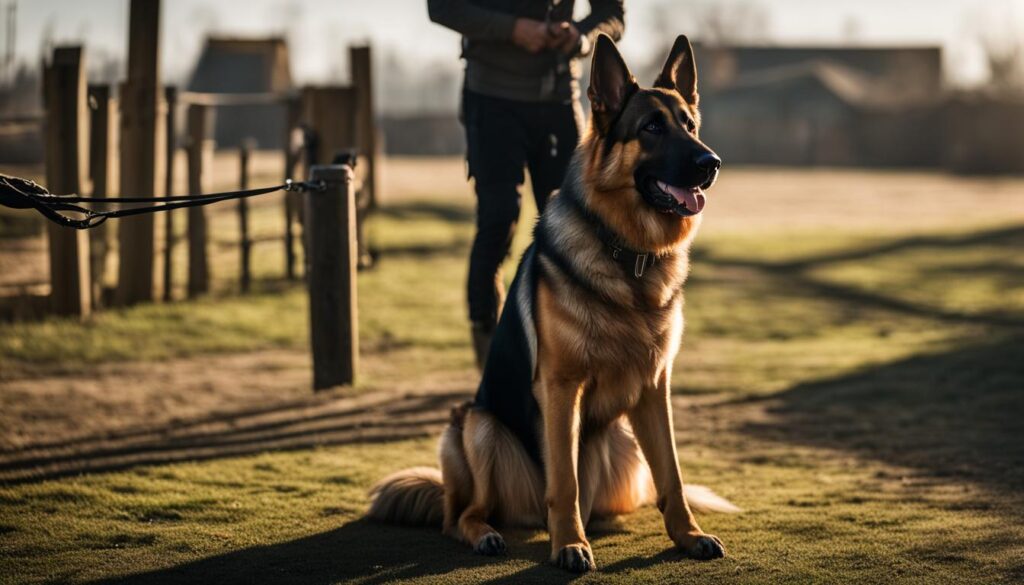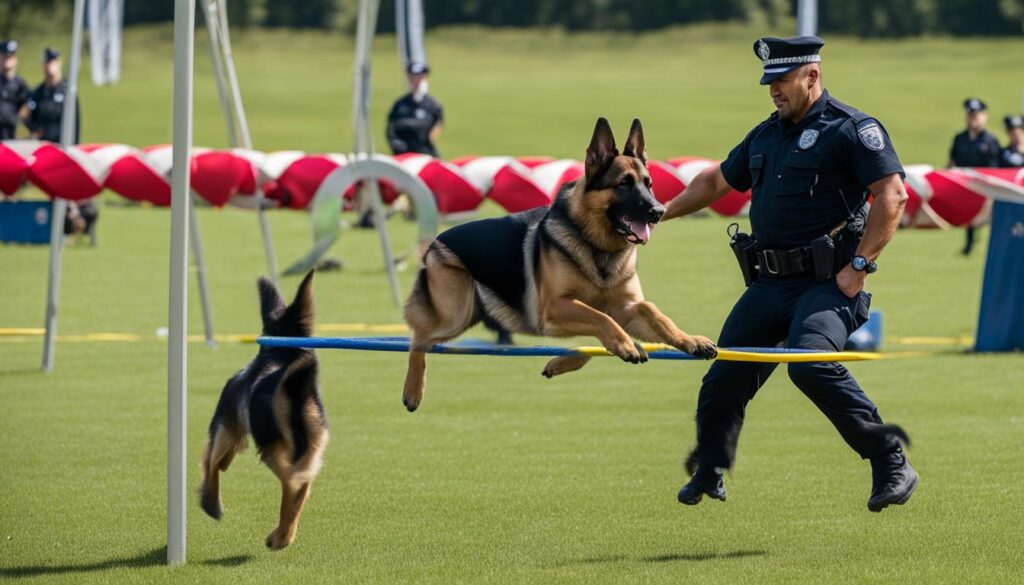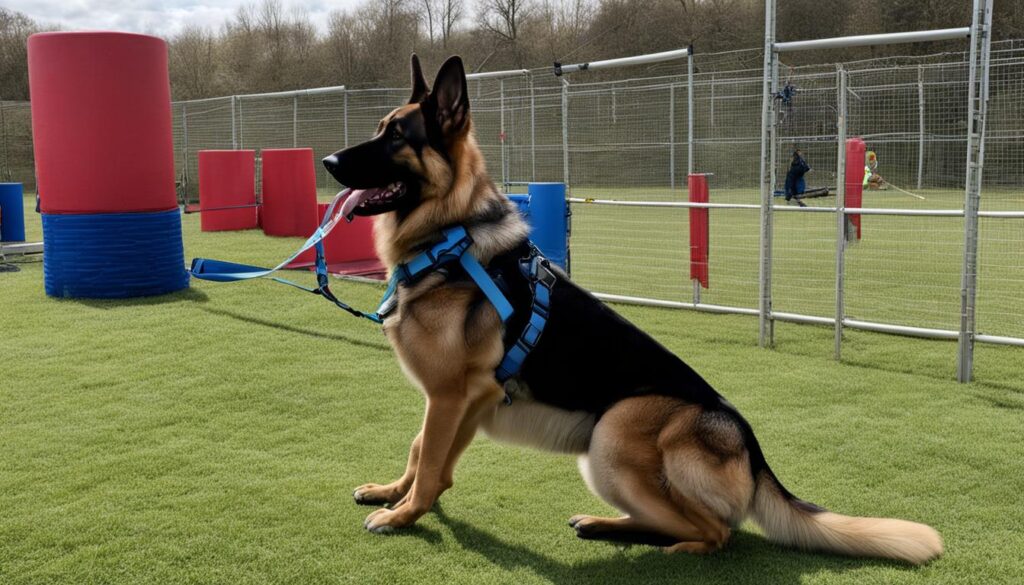If you’re looking to transform your German Shepherd into a well-trained police dog, you need to learn the proper training techniques. German Shepherds are commonly used in police work due to their intelligence, loyalty, and physical abilities. In this guide, we’ll cover all aspects of German Shepherd training required for police work, from basic obedience training to more advanced protective and agility techniques.
Key Takeaways:
- Proper training techniques are crucial to transform your German Shepherd into a police dog.
- German Shepherds are commonly used in police work due to their intelligence, loyalty, and physical abilities.
- In this guide, we’ll cover all aspects of German Shepherd training required for police work.
- Topics covered will include basic obedience training, protective training, and agility training.
- By following the guidance in this guide, you’ll be well on your way to transforming your German Shepherd into an obedient, protective, and agile police dog.
German Shepherd Obedience Training for Police Dogs
Training your German Shepherd to become a well-trained police dog requires a sturdy foundation of obedience training. In this section, we’ll go over essential commands that every police dog must know, such as sit, stay, recall, and heel. By mastering these commands, your German Shepherd will be well on its way to a successful career as a police dog.
Aside from the commands themselves, it’s important to handle your dog correctly when training obedience. This includes understanding how to use a leash properly, and how to reinforce good behavior through positive reinforcement techniques. Consistency and patience are the keys to success for obedience training of German Shepherd police dogs.


By using consistent training methods and rewarding your dog’s successes, you’ll see progress in no time. It’s crucial to remember that every dog learns differently and at its own pace, so don’t get discouraged if you don’t see results right away. Keep at it, and you’ll have a German Shepherd that is obedient, reliable, and ready for police work.
German Shepherd Protection Training for Police Dogs
As a police dog, protection training is essential for your German Shepherd to apprehend suspects and keep their handler safe. This type of training develops your dog’s protective instincts, so they know when to act and when to stand down. Bite work, controlled aggression, and building confidence are the key components of German Shepherd protection training, and they all require consistency in training.
Bite work is a fundamental aspect of protection training, as it allows your dog to bite on command and hold until told to release. To prevent injuries, you need to work with a professional trainer who specializes in bite work. Controlled aggression teaches your German Shepherd to remain calm and composed on the job, even in high-pressure situations, while building confidence helps them trust their instincts and act accordingly.
Behavior training is also crucial in ensuring your German Shepherd is a well-balanced and reliable police dog. It covers topics such as socialization, obedience, and problem-solving skills, all of which are vital for a successful police dog. Through this type of training, your German Shepherd will be more equipped to handle real-life situations and display the necessary behaviors to excel as a police dog.


Tip: Establishing a good relationship with your dog through positive reinforcements and rewards can help improve their learning and performance during training.
German Shepherd Agility Training for Police Dogs
Agility training is an important part of police dog training. This type of training focuses on enhancing your German Shepherd’s coordination and athletic ability. By introducing agility equipment and obstacles, you can help your dog become more confident and agile in their movements.
In order to start agility training with your German Shepherd, it’s important to first assess their physical fitness and abilities. Once you’ve determined they’re ready for the training, you can begin introducing them to the various obstacles.
Introducing Agility Equipment
Agility equipment used in police dog training includes hurdles, tunnels, weave poles, and A-frames. Each obstacle requires your German Shepherd to navigate it in a specific way, making it important to introduce each obstacle slowly and patiently.
Start by allowing your dog to explore each obstacle without any pressure to perform. This helps them become accustomed to the equipment and develop confidence in their abilities.
Once they’re comfortable with each obstacle separately, gradually work on incorporating multiple obstacles in a sequence. Always reward them for their progress and avoid pushing them too hard.
Incorporating Agility Exercises
Agility exercises can also be incorporated into your training sessions to further develop your German Shepherd’s agility and coordination. These exercises include lateral movements, side-to-side jumps, and pivot turns, among others.
Incorporating agility exercises and obstacles helps prepare your German Shepherd for real-life scenarios in the field.
German Shepherd Police Dog Commands for Agility Training
To direct your German Shepherd during agility training and field operations, you’ll need to incorporate specific commands and signals. These commands include “over” for jumping over obstacles, “through” for going through tunnels, and “weave” for navigating weave poles.


Agility training can be a fun and rewarding aspect of police dog training, but it’s important to take it slow and ensure your German Shepherd is comfortable with each obstacle and exercise. By incorporating agility training into your overall training program, you can help your German Shepherd become a well-rounded and capable police dog.
Conclusion
Congratulations on completing this guide on how to train your German Shepherd like a police dog! With consistency, patience, and dedication, you can transform your furry friend into a reliable and well-trained police dog.
Remember to prioritize your dog’s well-being and safety throughout the training process. With proper obedience, protection, and agility training, your German Shepherd can become an asset in law enforcement or a valuable companion in your daily life.
Don’t hesitate to seek professional guidance or support from experienced trainers if necessary. With time and effort, you and your German Shepherd can achieve remarkable results and enjoy a fulfilling partnership.
FAQ
What is German Shepherd obedience training?
German Shepherd obedience training focuses on teaching your dog essential commands and behaviors, such as sit, stay, recall, and heel. It forms the foundation for all police dog training and helps create a well-trained and disciplined dog.
How can I train my German Shepherd to listen to my commands?
To train your German Shepherd to listen to your commands, it is important to use positive reinforcement techniques, such as treats and praise, to reward desirable behaviors. Consistency, patience, and regular training sessions are also key to developing a strong bond and effective communication with your dog.
What is involved in German Shepherd protection training for police dogs?
German Shepherd protection training involves teaching your dog controlled aggression, bite work, and guarding skills. This training helps develop your dog’s natural protective instincts, making them capable of protecting their handler and apprehending suspects when necessary.
How can I ensure my German Shepherd is well-behaved and balanced as a police dog?
Behavior training is essential for creating a well-balanced and reliable police dog. This training focuses on addressing any behavioral issues your German Shepherd may have, such as excessive barking or aggression, and teaching them proper socialization skills. Consistency, positive reinforcement, and firm but fair training methods are key to achieving a well-behaved police dog.
What is German Shepherd agility training for police dogs?
German Shepherd agility training involves teaching your dog to navigate obstacles, such as tunnels, jumps, and weave poles, in a fast and efficient manner. Agility training enhances your dog’s athleticism, coordination, and focus, making them more effective in field operations as a police dog.
What commands are important for directing a German Shepherd police dog?
Commands such as “sit,” “stay,” “down,” “come,” “heel,” and “search” are essential for directing a German Shepherd police dog during field operations. Consistent training and repetition of these commands, along with the use of hand signals and verbal cues, help your dog understand and respond appropriately in different scenarios.

